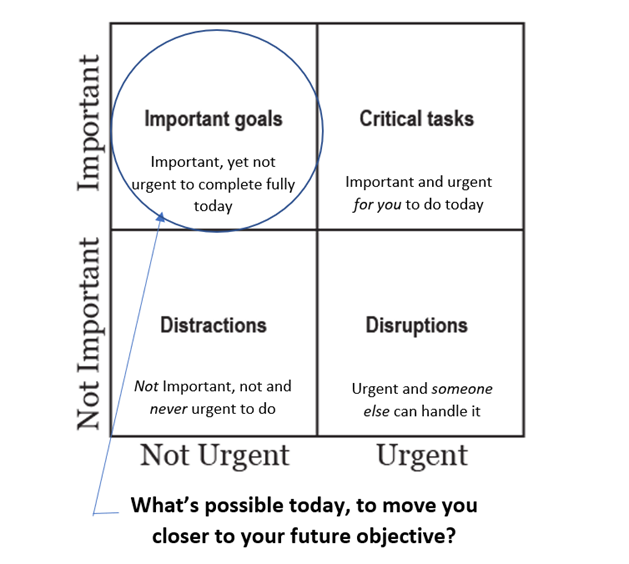You’re still considering your day. In Part II you focused on “what” you want. In Part III you then considered that “what” and focused on “who” can help you and who might you serve.
Now you are homing in on “how,” and more specifically, “How will what you do today address “what” you want and “who” can help or who you can serve?” What’s the reality of today? What can you do to make sure that the steps you take today are the best steps possible for a better future?
The Eisenhower Box
The image above is of The Eisenhower Box, slightly modified to put “Important, yet not urgent” in the top left box, to match the tone of this post
In case you are not familiar with The Eisenhower Box, the following is how each box is typically described:
-
- Important, Not Urgent – What you must do at some point in the future.
- Important, Urgent – What you must do today.
- Urgent, Not Important – What must be done, yet can be delegated.
- Not Urgent, Not Important – Distractions that do not serve you.
Why consider today that which can be scheduled for another day?
Too often, “Important, Not Urgent” gets pushed out day after day, and never done.
Sometimes, of course, it makes sense to pick a day (or days) in the future to address it, and make sure what needs to be done happens on those days.
If you have any inclination toward procrastination (you push the tough stuff out again, and again, and it never gets addressed) or overwhelm (if something that needs to be done is too big, you feel anxious and don’t do it well), then you need to break any important milestone into do-able steps, over time.
A quick and common example is a leader having an objective to make the next set of employee performance reviews… less awful (and to also not be late on giving any of them). Perhaps the objective is named “Simpler, timely, effective reviews.” I hear about this often and also hear reasons why the objective wasn’t met, usually with regret.
Breaking the “Simpler, timely, effective reviews” objective down might include a series of questions that require smaller actions, yet build momentum toward the goal. Questions and actions might include, “Software or manual forms?”, “Start semi-weekly 1:1 chats”, “Team or smaller group meetings to define an ‘effective’ review”, and “Check-in with HR and my manager.”
I recommend you consider important future milestones, steps, objectives, and desired outcomes—“What Matters Most”—every morning or night prior to make sure you are positioning yourself for the best future possible.
Your best next step
For your “Your 1 Best Next Step,” before your day starts tomorrow, look at what you wrote (or thought) as what you want and who can help, and then consider the reality of today.

